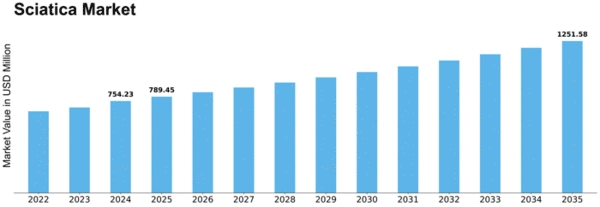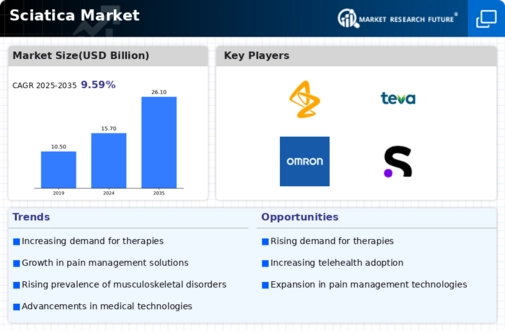-
Report Prologue
-
Market Introduction
-
Definition
-
Scope of the Study
- Research Objective
- Assumptions
- Limitations
-
Research Methodology
-
Introduction
-
Primary Research
-
Secondary research
-
Market Size Estimation
-
Market Dynamics
-
Drivers
-
Restrains
-
Opportunities
-
Challenges
-
Macroeconomic Indicators
-
Technology Trends & Assessment
-
Market Factor Analysis
-
Porters Five Forces Analysis
-
Value Chain Analysis
-
Investment Feasibility Analysis
-
Pricing Analysis
-
Global Sciatica Market, by Type
-
Introduction
-
L4 Nerve Root Sciatica
- Market Estimates & Forecast, 2020-2027
-
L5 Nerve Root Sciatica
- Market Estimates & Forecast, 2020-2027
-
S1 Nerve Root Sciatica
- Market Estimates & Forecast, 2020-2027
-
Others
- Market Estimates & Forecast, 2020-2027
-
Global Sciatica Market, by Drug Treatment
-
Introduction
-
Anesthetics
- Market Estimates & Forecast, 2020-2027
-
Pain Killers
- Market Estimates & Forecast, 2020-2027
-
Muscle Relaxants
- Market Estimates & Forecast, 2020-2027
-
Antidepressants
- Market Estimates & Forecast, 2020-2027
-
Steroids
- Market Estimates & Forecast, 2020-2027
-
Others
- Market Estimates & Forecast, 2020-2027
-
Global Sciatica Market, by Non-drug Treatment
-
Introduction
-
Physiotherapy
- Market Estimates & Forecast, 2020-2027
-
Acupuncture
- Market Estimates & Forecast, 2020-2027
-
Stimulation Devices
- Market Estimates & Forecast, 2020-2027
-
Surgery
- Market Estimates & Forecast, 2020-2027
-
Others
- Market Estimates & Forecast, 2020-2027
-
Global Sciatica Market, by End User
-
Introduction
-
Hospitals and Clinics
- Market Estimates & Forecast, 2020-2027
-
Research and Academics
- Market Estimates & Forecast, 2020-2027
-
Others
- Market Estimates & Forecast, 2020-2027
-
Global Sciatica Market, by Region
-
Introduction
-
Americas
- North America
- South America
-
Europe
- Western Europe
- Eastern Europe
-
Asia Pacific
- Japan
- China
- India
- Australia
- Republic of Korea
- Rest of Asia Pacific
-
The Middle East & Africa
- United Arab Emirates
- Saudi Arabia
- Oman
- Kuwait
- Qatar
- Rest of the Middle East & Africa
-
Company Landscape
-
Introduction
-
Market Share Analysis
-
Key Development & Strategies
- Key Developments
-
Company Profiles
-
Endo Pharmaceuticals
- Overview
- Product Overview
- Financials
-
AstraZeneca
- Overview
- Product Overview
- Financials
- Key Developments
-
Novartis AG
- Overview
- Product Overview
- Financials
- Key Development
-
Teva Pharmaceutical Industries
- Overview
- Product Overview
- Financials
- Key Development
-
Neurotech
- Overview
- Product Overview
- Financials
- Key Development
-
Nidd Valley Medical
- Overview
- Product Overview
- Financials
- Key Development
-
Omega Laser Systems Ltd.
- Overview
- Product Overview
- Financials
- Key Development
-
Omron Healthcare, Inc.
- Overview
- Product Overview
- Financials
- Key Development
-
Others
-
MRFR Conclusion
-
Key Findings
- From CEO’s View Point
- Unmet Needs of the Market
-
Key Companies to Watch
-
Prediction of Sciatica Industry
-
Appendix
-
List of Tables
-
GLOBAL SCIATICA MARKET, BY TYPE, 2020-2027 (USD MILLION)
-
L4 NERVE ROOT SCIATICA FOR SCIATICA MARKET, BY REGION, 2020-2027 (USD MILLION)
-
L5 NERVE ROOT SCIATICA FOR SCIATICA MARKET, BY REGION 2020-2027 (USD
-
MILLION)
-
S1 NERVE ROOT SCIATICA FOR SCIATICA MARKET, BY REGION 2020-2027 (USD MILLION)
-
OTHER FOR SCIATICA MARKET, BY REGION 2020-2027 (USD MILLION)
-
GLOBAL SCIATICA MARKET, BY DRUG TREATMENT, 2020-2027 (USD MILLION)
-
ANESTHETICS FOR SCIATICA MARKET, BY REGION, 2020-2027 (USD MILLION)
-
PAIN KILLERS FOR SCIATICA MARKET, BY REGION 2020-2027 (USD MILLION)
-
MUSCLE RELAXANTS FOR SCIATICA MARKET, BY REGION 2020-2027 (USD MILLION)
-
ANTIDEPRESSANTS FOR SCIATICA MARKET, BY REGION 2020-2027 (USD MILLION)
-
STEROIDS FOR SCIATICA MARKET, BY REGION 2020-2027 (USD MILLION)
-
OTHERS FOR SCIATICA MARKET, BY REGION 2020-2027 (USD MILLION)
-
GLOBAL SCIATICA MARKET, BY NON-DRUG TREATMENT, 2020-2027 (USD MILLION)
-
PHYSIOTHERAPY FOR SCIATICA MARKET, BY REGION, 2020-2027 (USD MILLION)
-
ACUPUNCTURE FOR SCIATICA MARKET, BY REGION 2020-2027 (USD MILLION)
-
STIMULATION DEVICES FOR SCIATICA MARKET, BY REGION 2020-2027 (USD MILLION)
-
SURGERY FOR SCIATICA MARKET, BY REGION 2020-2027 (USD MILLION)
-
OTHERS FOR SCIATICA MARKET, BY REGION 2020-2027 (USD MILLION)
-
GLOBAL SCIATICA MARKET, BY END USER, 2020-2027 (USD MILLION)
-
NORTH AMERICA SCIATICA MARKET, BY COUNTRY 2020-2027 (USD MILLION)
-
NORTH AMERICA SCIATICA MARKET, BY TYPE 2020-2027 (USD MILLION)
-
NORTH AMERICA SCIATICA MARKET, BY DRUG TREATMENT 2020-2027 (USD MILLION)
-
NORTH AMERICA SCIATICA MARKET, BY NON-DRUG TREATMENT 2020-2027 (USD MILLION)
-
NORTH AMERICA SCIATICA MARKET, BY END USER, 2020-2027 (USD MILLION)
-
NORTH AMERICA SCIATICA MARKET BY REGION 2020-2027 (USD MILLION)
-
EUROPE SCIATICA MARKET, BY COUNTRY 2020-2027 (USD MILLION)
-
EUROPE SCIATICA MARKET, BY TYPE 2020-2027 (USD MILLION)
-
EUROPE SCIATICA MARKET, BY DRUG TREATMENT 2020-2027 (USD MILLION)
-
EUROPE SCIATICA MARKET, BY NON-DRUG TREATMENT 2020-2027 (USD MILLION)
-
EUROPE SCIATICA MARKET, BY END USER, 2020-2027 (USD MILLION)
-
EUROPE SCIATICA MARKET BY REGION 2020-2027 (USD MILLION)
-
ASIA PACIFIC SCIATICA MARKET, BY COUNTRY 2020-2027 (USD MILLION)
-
ASIA PACIFIC SCIATICA MARKET, BY TYPE 2020-2027 (USD MILLION)
-
ASIA PACIFIC SCIATICA MARKET, BY DRUG TREATMENT 2020-2027 (USD MILLION)
-
ASIA PACIFIC SCIATICA MARKET, BY NON-DRUG TREATMENT 2020-2027 (USD MILLION)
-
ASIA PACIFIC SCIATICA MARKET, BY END USER, 2020-2027 (USD MILLION)
-
ASIA PACIFIC SCIATICA MARKET BY REGION 2020-2027 (USD MILLION
-
MIDDLE EAST & AFRICA SCIATICA MARKET, BY COUNTRY 2020-2027 (USD MILLION)
-
MIDDLE EAST & AFRICA SCIATICA MARKET, BY TYPE 2020-2027 (USD MILLION)
-
MIDDLE EAST & AFRICA SCIATICA MARKET, BY DRUG TREATMENT 2020-2027 (USD MILLION)
-
MIDDLE EAST & AFRICA SCIATICA MARKET, BY NON-DRUG TREATMENT 2020-2027 (USD MILLION)
-
MIDDLE EAST & AFRICA SCIATICA MARKET, BY END USER, 2020-2027 (USD MILLION)
-
MIDDLE EAST & AFRICA SCIATICA MARKET BY REGION 2020-2027 (USD MILLION
-
List of Figures
-
RESEARCH PROCESS
-
MARKET DYNAMICS FOR GLOBAL SCIATICA MARKET
-
GLOBAL SCIATICA MAKRET, BY SEGMENT, 2020
-
GLOBAL SCIATICA SUCCESS MARKET, BY REGION
-
GLOBAL SCIATICA MARKET SHARE, BY TYPE 2020
-
GLOBAL SCIATICA MARKET SHARE, BY DRUG TREATMENT 2020
-
GLOBAL SCIATICA MARKET SHARE, BY NON-DRUG TREATMENT 2020
-
GLOBAL SCIATICA MARKET SHARE, BY END USER, 2020
-
GLOBAL SCIATICA MARKET SHARE, 2020
-
GLOBAL SCIATICA MARKET SHARE, BY REGION, 2020
-
NORTH AMERICA SCIATICA MARKET SHARE, BY COUNTRY, 2020
-
EUROPE SCIATICA MARKET SHARE, BY COUNTRY, 2020
-
ASIA PACIFIC SCIATICA MARKET SHARE, BY COUNTRY, 2020
-
MIDDLE EAST & AFRICA SCIATICA MARKET, BY REGION, 2020
-
GLOBAL SCIATICA MARKET: COMPANY SHARE ANALYSIS, 2020 (%)
-
ENDO PHARMACEUTICALS: KEY FINANCIALS
-
ENDO PHARMACEUTICALS: SEGMENTAL REVENUE
-
ENDO PHARMACEUTICALS: GEOGRAPHICAL REVENUE
-
ASTRAZENECA: KEY FINANCIALS
-
ASTRAZENECA SEGMENTAL REVENUE
-
ASTRAZENECA: GEOGRAPHICAL REVENUE
-
OMRON HEALTHCARE, INC: KEY FINANCIALS
-
OMRON HEALTHCARE, INC: SEGMENTAL REVENUE
-
OMRON HEALTHCARE, INC: GEOGRAPHICAL REVENUE
-
NIDD VALLEY MEDICAL: KEY FINANCIALS
-
NIDD VALLEY MEDICAL: SEGMENTAL REVENUE
-
NIDD VALLEY MEDICAL: GEOGRAPHICAL REVENUE
-
OMEGA LASER SYSTEMS LTD: FINANCIAL REVENUE
-
OMEGA LASER SYSTEMS LTD: SEGMENTAL REVENUE
-
OMEGA LASER SYSTEMS LTD: GEOGRPAHICAL REVENUE


















Leave a Comment